“Hide matches from children!” Or what (not) warns the Ministry of Health
Matchstick label collectors are well aware of the beginning of the phrase in the title of this publication. This warning in various forms was often applied to the labels of small boxes in Soviet times. One may indignantly ask: "And where does it mean," Geek Health "and the same Ministry of Health?" - I will answer: “So, at first they tell a tale, and the tale will be ahead ...”
The cause of the fire that broke one of the private houses in San Leandro, California on Saturday was a “hoverboard” connected to charging ...
The US Consumer Product Safety Commission announced 20 January to launch an investigation into the safety of this popular toy related to at least 40 fires in 19 states. Amazon offers a refund to anyone who has bought hoverboards on its website.
It is believed that the blame lies with lithium-ion batteries installed inside the product.
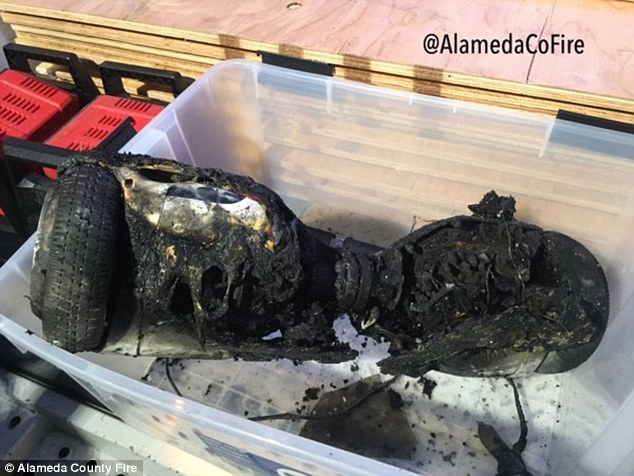
This Twitter image by Alameda County firefighters shows one of the hoverboards accused of a series of fires in the United States.
For those who did not recognize this product in the photo, we explain that the hoverboards, which were one of the most popular gifts on Christmas 2014, are a two-wheeled, battery-powered scooter.
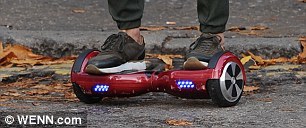
Such a hoverboard allows riders to reach a speed of 16 km / h.
However, not just hoverboards, but millions of devices, from laptops to phones and e-cigarettes, are equipped with similar batteries. The best examples of devices using such batteries have special sensors that prevent batteries from overheating and overloading, which reduces the likelihood of fire. However, most “non-branded” products do not have such security systems.
Leon Livermore of the Royal Institute for Trade Standards in the UK, said: “Irresponsible producers often use high demand and try to flood the market with cheap and dangerous products. And buyers should not leave such devices unattended while charging. ”
That's just what to do with laptops and vacuum cleaners, robots that remain in our homes while we are at work. Do not take them with you?
On January 27, 2016, the UN Aviation Commission recommended banning the carriage of rechargeable lithium batteries by passenger airliners, since batteries could cause fires that could destroy aircraft.
The Air Navigation Commission of the International Civil Aviation Organization (ICAO) has proposed removing this ban if a new package is developed that provides an acceptable level of security. However, the final decision requires approval from ICAO management. It is planned that the ICAO High Council will consider this issue at the end of February.
About 5.4 billion lithium-ion batteries were manufactured worldwide in 2014 alone. Most of them are transported by cargo ships, but approximately 30% are transported using aircraft.
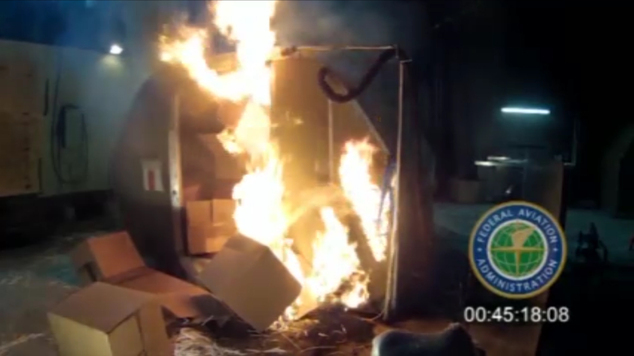
In this image, you see a shot of a video provided by the United States Federal Aviation Administration (FAA) demonstrating a test performed in April 2015 by its Atlantic City technology center.
The technical center simulated the ignition of a cargo container with 5,000 rechargeable lithium-ion batteries (photo AP / FAA). FAA tests show that a single damaged or defective battery can lead to an uncontrolled temperature increase that can spread to the entire load. In the FAA tests, overheated batteries became a source of explosive gases, which were able to blow up the doors of the cargo container and destroy the cargo compartments of the aircraft.
The proposed ban will not apply to cargo aircraft, despite the efforts of the International Federation of Airline Pilot Associations. Security experts believe at least three cargo planes have been destroyed by ignition of lithium batteries since 2006. In these accidents killed four pilots. Last March, an organization representing aircraft manufacturers (including Boeing and Airbus) told ICAO that the liners were not able to withstand ignition of lithium batteries and continued to believe that the load of such batteries was an “unacceptable risk”.
Six months later, the United States decided to support the ban. But battery manufacturers, trading companies, and the International Air Transport Association are strongly resisting. They say that only products of “shadow” manufacturers, mainly Chinese, bear the risk.
At the end of October 2015, the ICAO Dangerous Goods Transport Group voted against the ban with 11 votes to 7. The United States, Russia, Brazil, China and Spain, as well as organizations representing pilots and aircraft manufacturers, voted for him. The Netherlands, Canada, France, Germany, Australia, Italy, the United Arab Emirates, South Korea, Japan and the United Kingdom, as well as the airline trade group, voted against.
But at least 20 airlines that fly on international routes voluntarily decided to no longer accept cargo with such batteries.
The U.S. government strongly urged airlines to warn passengers not to pack spare lithium batteries in their luggage, as they could ignite and cause a fire.
The FAA recommends reminding airline passengers that they will be fined if this ban is violated. The Office also approached airlines, requiring flight crews and ground personnel to report all fires, explosions, and incidents of carbonization, reflow, or smoke caused by batteries or battery powered devices. The FAA Safety Alert came a day after the Alaska Airline flight crashed due to the smoke of a card reader in which the batteries melted. None of the 184 passengers and five crew members were injured, and the smoke was extinguished by a fire extinguisher.
The man received terrible burns after a spare e-cigarette battery exploded in his trouser pocket.
David Yeo, 35, was at home with his girlfriend when the spare battery in his pocket suddenly caught fire.
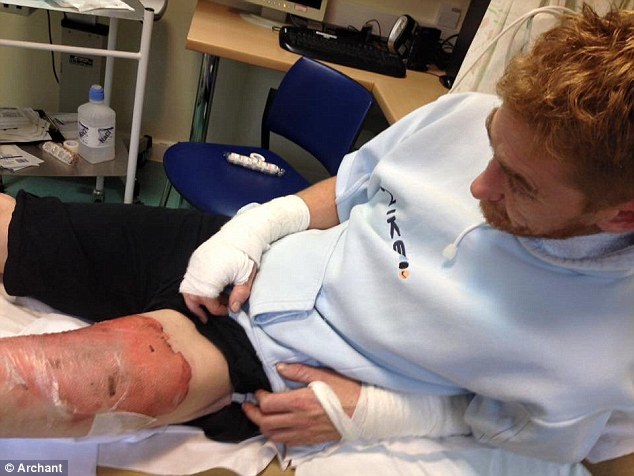
David Yeo received a third degree burn on his right leg and injured both hands.
Now he warns thousands of other e-cigarette users to be very careful. He said: “There was a strong explosion, and flames of fire directly shot out of his pocket. It looked like a Roman candle firework. I managed to rip off my jeans, but by then it was already too late. I was very lucky that my girlfriend was nearby. She shot down the flames while I tried to take off my jeans. ”
Tom Pruen, a senior fellow at the Electronic Industry Trade Association, has warned against storing electronic cigarette batteries near metal objects such as keys and coins. He said: “A pocket change can short-circuit an electrical circuit between the battery terminals, creating a short circuit leading to overheating and even a fire. This applies not only to electronic cigarette batteries, but also to all batteries with open contacts. In electronic cigarettes, the battery terminals are closed, so this problem only applies to spare batteries. ”
And finally, there’s a fairy tale connected with the Ministry of Health ...
A two-year-old girl in rural Oklahoma died two days after Christmas 2015, and the doctors blame this on a small battery-tablet.
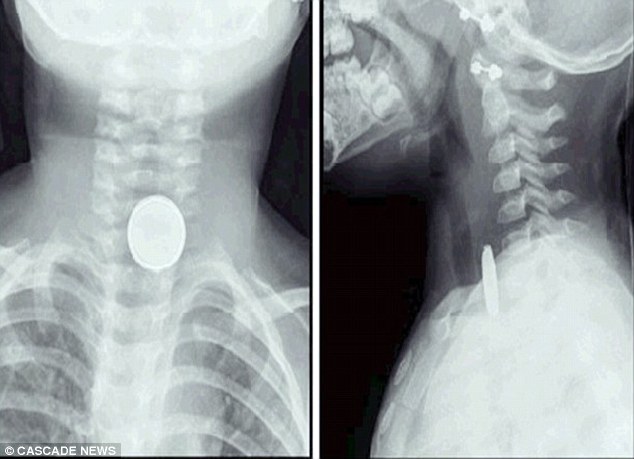
The baby's parents called an ambulance when her daughter started vomiting blood and she turned blue. The baby was rushed to the hospital, she underwent surgery immediately, but she died. She was operated on, but the doctors could not stop the bleeding. The battery burned through the esophagus and carotid artery.
Parents do not know how the baby swallowed the battery. Doctors believe that the little girl swallowed her for another six days of her death.
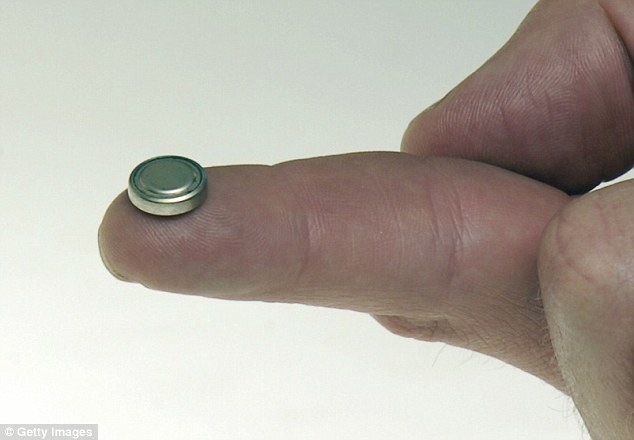
Experts say that batteries often pass through the esophagus and intestines without causing harm. Fatalities occur when the battery gets stuck and releases alkaline substance.
According to National Capital Poison CenterFrom 2004 to 2014, 11 940 cases were recorded in the United States when children swallowed batteries, and in 15 cases, children died. There are several reports of child deaths in Britain and Australia. There are also reports of batteries swallowed by older people who confused them with their pills.
New cases of deaths and serious injuries in children who swallowed miniature tablet batteries led British doctors to launch ahead of Christmas 2015 ( another) propaganda campaign. This campaign included not only shocking photos, but also a video of a miniature battery that burns the stuffing of a hot dog, during an experiment demonstrating what can happen in the baby’s esophagus. Batteries are usually found in toys and gadgets (in car remote controls, TV remotes, musical greeting cards, talking dolls, etc.).
The campaign’s goal is to eliminate mortality and injuries from the thousands of potentially deadly lithium batteries available inside the many toys that children give on New Year’s Eve.
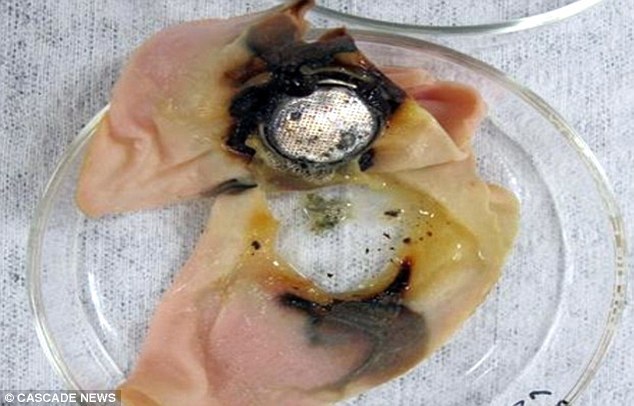
Experts inserted a battery into pieces of meat to demonstrate its likely effect on human flesh. The photo shows the results of such experiments.

After two hours, a small battery left charred marks on the sausage. The demo video shows that just three hours after one of these batteries was inserted into the hot dog sausage, it completely burned the sausage. This clearly shows: the same thing can happen with human flesh.
When ingested, lithium batteries can cause a chemical reaction with saliva, with the release of alkali, which can burn through the walls of the esophagus and other organs.
Here is a description of one such case.
Nicolas Shoesmith's mother was the first to notice something was wrong when Ellie started vomiting one evening in May 2014. But when Nicolas brought 18-month-old Ellie to the doctor, he said that it was simply heartburn and refused to send her for an X-ray.
Ellie continued to cry while feeding. Nicolas went to the doctor every 2 to 3 days for three weeks with a request to give his daughter an x-ray, until, finally, he decided to send Ellie to the hospital. It turned out that Ellie urgently needed an operation. She had terrifying burns to her internal organs. After the operation, her mother was told that she was still at risk of fatal bleeding and would have to endure a series of debilitating operations to try to repair the damage.
The horror of Nicolas was compounded by bewilderment: the damage was caused by something completely unexpected and seemingly harmless - a flat miniature battery that Ellie swallowed, apparently thinking that it was delicious.
“It was a nightmare,” says Nicolas. “Ellie was finally released from the hospital in January, eight months after removing the battery. I was very afraid that Ally would die. I had no idea that swallowing a battery could do so much harm. ”
Ellie needed a series of operations under general anesthesia to increase the width of her esophagus. She underwent another operation at the Manchester Children's Hospital, two weeks after the battery was removed, and four operations over the next five months.
It wasn't until September that Ellie's esophagus recovered enough to start eating solid food. “My doctor said that if the battery stuck a little higher and closer to the artery, it would die,” says Nicolas.
When the battery gets stuck, it comes into contact with the mucous membrane of the esophagus, and its electric current causes the release of sodium hydroxide (caustic soda), which causes terrible burns. Even after the battery is removed, the action of alkali continues for some time. One child who put a battery-tablet in the nostril of the nose was forever left with a damaged septum. It simply burned out, despite the fact that the battery was removed after only a few hours.
How to protect yourself and what to do if the worst happens:
1. Do not allow children to take devices with tablet batteries if their battery compartments are not protected. Lock spare batteries.
2. Take the child to the hospital: if the child swallows a battery or it is stuck in his nose or ear.
3. Do not let them eat or drink anything.
4. It is important to get to the hospital as soon as possible. The faster the battery can be removed, the less chance of permanent damage.
5. Share this information: parents need to know what to do if the worst happens.
Although new batteries are more toxic, even those that stop working are dangerous. It is necessary to store and dispose of them very carefully.
Back in December 2014 , the UK government department of health sent out a special information letter for distribution in nurseries, kindergartens and schools:
“Children under the age of six are at greatest risk, but severe trauma can occur in any age group. The most serious cases are related to the new lithium batteries about 20 mm in size. They can get stuck in the throat, where the battery can do huge damage in as little as two hours. Symptoms of swallowing a battery include nausea, fever, and coughing. But, parents should be aware that there may be no symptoms at first or that the symptoms may be similar to other illnesses, such as coughing or refusing to eat or drink. It is imperative to get to the hospital as soon as possible. ”
In this regard, a few words about the Ministry of Health. For many, it came as a surprise that Russia (suddenly) felt the “economic pressure” of the inefficiency of its health care system - this is what the latest reforms have caused, which have stirred up both the doctors and the public. The Russian healthcare system lacks funds, and the reformers decided to cut back on doctors. Moscow (the “financial crossroads of Russia") even provided redundant workers with additional (not prescribed by law) compensation. However, many specialists, including a well-known doctor (head physician of the city hospital No. 71 of the city of Moscow) A.V. Myasnikov, say that it was more logical to start not with the reform of the healthcare system, but with the reform of Russian medicine.
It is more important that there appear standards of medical education, diagnostic standards, standards and “stop lists” for each type of surgical intervention. Even countries such as Brazil (“where there are a lot of monkeys”) and Mexico, to which Russians have traditionally been somewhat condescending, have such standards. But in Russia they are not. In fact, it is impossible that, as before, three different doctors could make three different diagnoses and prescribe three different treatment options. It is impossible that in Russia (for commercial reasons or out of ignorance) they operated on something that had not been operated on "in the West" for a long time. Doctors are required to constantly learn, and for this you need to know the languages. Just like in the “west”, doctors must confirm that they have the necessary qualifications by passing tests on a quarterly basis, and once in 3 years they must pass (informal) exams. Finally, medicine should,
Since the end of the 20th century, non-communicable diseases have come to the fore in all developed countries. The WHO Global Plan of Action for the Control and Prevention of Noncommunicable Diseases 2013–2020, adopted by WHO (by the way, in Moscow), states: “The cost of inaction is much higher than the cost of action ... The economic impact of noncommunicable diseases in low- and middle-income countries is equivalent to their current gross domestic product ... Continued failure to act led to the escalation of health care costs ... " .
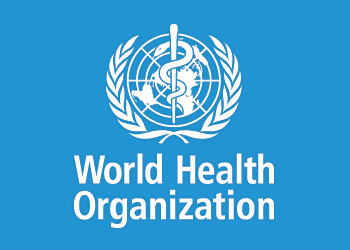
Further, in the "Global Plan ..." the only possible solution to the problem is indicated: "Goal No. 1 - to increase the priority of disease prevention". But, excuse me, what kind of prevention can we talk about if no one talks to Russians (unlike marketers - truthfully and clearly) even about the causes of massive (socially significant) diseases that can be completely avoided? Can we imagine that the Ministry of Health of the Russian Federation (please forgive me for the blasphemy of the words that will be heard later) will write and send out a special information letter warning parents, educators and doctors over several children's lives?
As early as the beginning of 2015 (immediately after the publication of information on the case of Nicolas and Ellie in the Daily Mail), we published this information in our Vkontakte health community and tried to post it in other communities supposedly aimed at ensuring children's health. As a result, we were blacklisted by these communities, and the Daily Mail links were instantly deleted. As the saying goes: "They didn’t get through!" But, a year later, we see that batteries continue to kill children around the world (I would like to think differently, but this is unlikely in Russia). It would be nice if the Russian Ministry of Health informed the Russians about this. Is not it? But it turns out that you need to act almost on the motto of the airborne troops: "If not us, then who?"

The cause of the fire that broke one of the private houses in San Leandro, California on Saturday was a “hoverboard” connected to charging ...
The US Consumer Product Safety Commission announced 20 January to launch an investigation into the safety of this popular toy related to at least 40 fires in 19 states. Amazon offers a refund to anyone who has bought hoverboards on its website.
It is believed that the blame lies with lithium-ion batteries installed inside the product.

This Twitter image by Alameda County firefighters shows one of the hoverboards accused of a series of fires in the United States.
For those who did not recognize this product in the photo, we explain that the hoverboards, which were one of the most popular gifts on Christmas 2014, are a two-wheeled, battery-powered scooter.

Such a hoverboard allows riders to reach a speed of 16 km / h.
However, not just hoverboards, but millions of devices, from laptops to phones and e-cigarettes, are equipped with similar batteries. The best examples of devices using such batteries have special sensors that prevent batteries from overheating and overloading, which reduces the likelihood of fire. However, most “non-branded” products do not have such security systems.
Leon Livermore of the Royal Institute for Trade Standards in the UK, said: “Irresponsible producers often use high demand and try to flood the market with cheap and dangerous products. And buyers should not leave such devices unattended while charging. ”
That's just what to do with laptops and vacuum cleaners, robots that remain in our homes while we are at work. Do not take them with you?
On January 27, 2016, the UN Aviation Commission recommended banning the carriage of rechargeable lithium batteries by passenger airliners, since batteries could cause fires that could destroy aircraft.
The Air Navigation Commission of the International Civil Aviation Organization (ICAO) has proposed removing this ban if a new package is developed that provides an acceptable level of security. However, the final decision requires approval from ICAO management. It is planned that the ICAO High Council will consider this issue at the end of February.
About 5.4 billion lithium-ion batteries were manufactured worldwide in 2014 alone. Most of them are transported by cargo ships, but approximately 30% are transported using aircraft.

In this image, you see a shot of a video provided by the United States Federal Aviation Administration (FAA) demonstrating a test performed in April 2015 by its Atlantic City technology center.
The technical center simulated the ignition of a cargo container with 5,000 rechargeable lithium-ion batteries (photo AP / FAA). FAA tests show that a single damaged or defective battery can lead to an uncontrolled temperature increase that can spread to the entire load. In the FAA tests, overheated batteries became a source of explosive gases, which were able to blow up the doors of the cargo container and destroy the cargo compartments of the aircraft.
The proposed ban will not apply to cargo aircraft, despite the efforts of the International Federation of Airline Pilot Associations. Security experts believe at least three cargo planes have been destroyed by ignition of lithium batteries since 2006. In these accidents killed four pilots. Last March, an organization representing aircraft manufacturers (including Boeing and Airbus) told ICAO that the liners were not able to withstand ignition of lithium batteries and continued to believe that the load of such batteries was an “unacceptable risk”.
Six months later, the United States decided to support the ban. But battery manufacturers, trading companies, and the International Air Transport Association are strongly resisting. They say that only products of “shadow” manufacturers, mainly Chinese, bear the risk.
At the end of October 2015, the ICAO Dangerous Goods Transport Group voted against the ban with 11 votes to 7. The United States, Russia, Brazil, China and Spain, as well as organizations representing pilots and aircraft manufacturers, voted for him. The Netherlands, Canada, France, Germany, Australia, Italy, the United Arab Emirates, South Korea, Japan and the United Kingdom, as well as the airline trade group, voted against.
But at least 20 airlines that fly on international routes voluntarily decided to no longer accept cargo with such batteries.
The U.S. government strongly urged airlines to warn passengers not to pack spare lithium batteries in their luggage, as they could ignite and cause a fire.
The FAA recommends reminding airline passengers that they will be fined if this ban is violated. The Office also approached airlines, requiring flight crews and ground personnel to report all fires, explosions, and incidents of carbonization, reflow, or smoke caused by batteries or battery powered devices. The FAA Safety Alert came a day after the Alaska Airline flight crashed due to the smoke of a card reader in which the batteries melted. None of the 184 passengers and five crew members were injured, and the smoke was extinguished by a fire extinguisher.
The man received terrible burns after a spare e-cigarette battery exploded in his trouser pocket.
David Yeo, 35, was at home with his girlfriend when the spare battery in his pocket suddenly caught fire.

David Yeo received a third degree burn on his right leg and injured both hands.
Now he warns thousands of other e-cigarette users to be very careful. He said: “There was a strong explosion, and flames of fire directly shot out of his pocket. It looked like a Roman candle firework. I managed to rip off my jeans, but by then it was already too late. I was very lucky that my girlfriend was nearby. She shot down the flames while I tried to take off my jeans. ”
Tom Pruen, a senior fellow at the Electronic Industry Trade Association, has warned against storing electronic cigarette batteries near metal objects such as keys and coins. He said: “A pocket change can short-circuit an electrical circuit between the battery terminals, creating a short circuit leading to overheating and even a fire. This applies not only to electronic cigarette batteries, but also to all batteries with open contacts. In electronic cigarettes, the battery terminals are closed, so this problem only applies to spare batteries. ”
And finally, there’s a fairy tale connected with the Ministry of Health ...
A two-year-old girl in rural Oklahoma died two days after Christmas 2015, and the doctors blame this on a small battery-tablet.

The baby's parents called an ambulance when her daughter started vomiting blood and she turned blue. The baby was rushed to the hospital, she underwent surgery immediately, but she died. She was operated on, but the doctors could not stop the bleeding. The battery burned through the esophagus and carotid artery.
Parents do not know how the baby swallowed the battery. Doctors believe that the little girl swallowed her for another six days of her death.

Experts say that batteries often pass through the esophagus and intestines without causing harm. Fatalities occur when the battery gets stuck and releases alkaline substance.
According to National Capital Poison CenterFrom 2004 to 2014, 11 940 cases were recorded in the United States when children swallowed batteries, and in 15 cases, children died. There are several reports of child deaths in Britain and Australia. There are also reports of batteries swallowed by older people who confused them with their pills.
New cases of deaths and serious injuries in children who swallowed miniature tablet batteries led British doctors to launch ahead of Christmas 2015 ( another) propaganda campaign. This campaign included not only shocking photos, but also a video of a miniature battery that burns the stuffing of a hot dog, during an experiment demonstrating what can happen in the baby’s esophagus. Batteries are usually found in toys and gadgets (in car remote controls, TV remotes, musical greeting cards, talking dolls, etc.).
The campaign’s goal is to eliminate mortality and injuries from the thousands of potentially deadly lithium batteries available inside the many toys that children give on New Year’s Eve.

Experts inserted a battery into pieces of meat to demonstrate its likely effect on human flesh. The photo shows the results of such experiments.

After two hours, a small battery left charred marks on the sausage. The demo video shows that just three hours after one of these batteries was inserted into the hot dog sausage, it completely burned the sausage. This clearly shows: the same thing can happen with human flesh.
When ingested, lithium batteries can cause a chemical reaction with saliva, with the release of alkali, which can burn through the walls of the esophagus and other organs.
Here is a description of one such case.
Nicolas Shoesmith's mother was the first to notice something was wrong when Ellie started vomiting one evening in May 2014. But when Nicolas brought 18-month-old Ellie to the doctor, he said that it was simply heartburn and refused to send her for an X-ray.
Ellie continued to cry while feeding. Nicolas went to the doctor every 2 to 3 days for three weeks with a request to give his daughter an x-ray, until, finally, he decided to send Ellie to the hospital. It turned out that Ellie urgently needed an operation. She had terrifying burns to her internal organs. After the operation, her mother was told that she was still at risk of fatal bleeding and would have to endure a series of debilitating operations to try to repair the damage.
The horror of Nicolas was compounded by bewilderment: the damage was caused by something completely unexpected and seemingly harmless - a flat miniature battery that Ellie swallowed, apparently thinking that it was delicious.
“It was a nightmare,” says Nicolas. “Ellie was finally released from the hospital in January, eight months after removing the battery. I was very afraid that Ally would die. I had no idea that swallowing a battery could do so much harm. ”
Ellie needed a series of operations under general anesthesia to increase the width of her esophagus. She underwent another operation at the Manchester Children's Hospital, two weeks after the battery was removed, and four operations over the next five months.
It wasn't until September that Ellie's esophagus recovered enough to start eating solid food. “My doctor said that if the battery stuck a little higher and closer to the artery, it would die,” says Nicolas.
When the battery gets stuck, it comes into contact with the mucous membrane of the esophagus, and its electric current causes the release of sodium hydroxide (caustic soda), which causes terrible burns. Even after the battery is removed, the action of alkali continues for some time. One child who put a battery-tablet in the nostril of the nose was forever left with a damaged septum. It simply burned out, despite the fact that the battery was removed after only a few hours.
How to protect yourself and what to do if the worst happens:
1. Do not allow children to take devices with tablet batteries if their battery compartments are not protected. Lock spare batteries.
2. Take the child to the hospital: if the child swallows a battery or it is stuck in his nose or ear.
3. Do not let them eat or drink anything.
4. It is important to get to the hospital as soon as possible. The faster the battery can be removed, the less chance of permanent damage.
5. Share this information: parents need to know what to do if the worst happens.
Although new batteries are more toxic, even those that stop working are dangerous. It is necessary to store and dispose of them very carefully.
Back in December 2014 , the UK government department of health sent out a special information letter for distribution in nurseries, kindergartens and schools:
“Children under the age of six are at greatest risk, but severe trauma can occur in any age group. The most serious cases are related to the new lithium batteries about 20 mm in size. They can get stuck in the throat, where the battery can do huge damage in as little as two hours. Symptoms of swallowing a battery include nausea, fever, and coughing. But, parents should be aware that there may be no symptoms at first or that the symptoms may be similar to other illnesses, such as coughing or refusing to eat or drink. It is imperative to get to the hospital as soon as possible. ”
In this regard, a few words about the Ministry of Health. For many, it came as a surprise that Russia (suddenly) felt the “economic pressure” of the inefficiency of its health care system - this is what the latest reforms have caused, which have stirred up both the doctors and the public. The Russian healthcare system lacks funds, and the reformers decided to cut back on doctors. Moscow (the “financial crossroads of Russia") even provided redundant workers with additional (not prescribed by law) compensation. However, many specialists, including a well-known doctor (head physician of the city hospital No. 71 of the city of Moscow) A.V. Myasnikov, say that it was more logical to start not with the reform of the healthcare system, but with the reform of Russian medicine.
It is more important that there appear standards of medical education, diagnostic standards, standards and “stop lists” for each type of surgical intervention. Even countries such as Brazil (“where there are a lot of monkeys”) and Mexico, to which Russians have traditionally been somewhat condescending, have such standards. But in Russia they are not. In fact, it is impossible that, as before, three different doctors could make three different diagnoses and prescribe three different treatment options. It is impossible that in Russia (for commercial reasons or out of ignorance) they operated on something that had not been operated on "in the West" for a long time. Doctors are required to constantly learn, and for this you need to know the languages. Just like in the “west”, doctors must confirm that they have the necessary qualifications by passing tests on a quarterly basis, and once in 3 years they must pass (informal) exams. Finally, medicine should,
Since the end of the 20th century, non-communicable diseases have come to the fore in all developed countries. The WHO Global Plan of Action for the Control and Prevention of Noncommunicable Diseases 2013–2020, adopted by WHO (by the way, in Moscow), states: “The cost of inaction is much higher than the cost of action ... The economic impact of noncommunicable diseases in low- and middle-income countries is equivalent to their current gross domestic product ... Continued failure to act led to the escalation of health care costs ... " .

Further, in the "Global Plan ..." the only possible solution to the problem is indicated: "Goal No. 1 - to increase the priority of disease prevention". But, excuse me, what kind of prevention can we talk about if no one talks to Russians (unlike marketers - truthfully and clearly) even about the causes of massive (socially significant) diseases that can be completely avoided? Can we imagine that the Ministry of Health of the Russian Federation (please forgive me for the blasphemy of the words that will be heard later) will write and send out a special information letter warning parents, educators and doctors over several children's lives?
As early as the beginning of 2015 (immediately after the publication of information on the case of Nicolas and Ellie in the Daily Mail), we published this information in our Vkontakte health community and tried to post it in other communities supposedly aimed at ensuring children's health. As a result, we were blacklisted by these communities, and the Daily Mail links were instantly deleted. As the saying goes: "They didn’t get through!" But, a year later, we see that batteries continue to kill children around the world (I would like to think differently, but this is unlikely in Russia). It would be nice if the Russian Ministry of Health informed the Russians about this. Is not it? But it turns out that you need to act almost on the motto of the airborne troops: "If not us, then who?"

